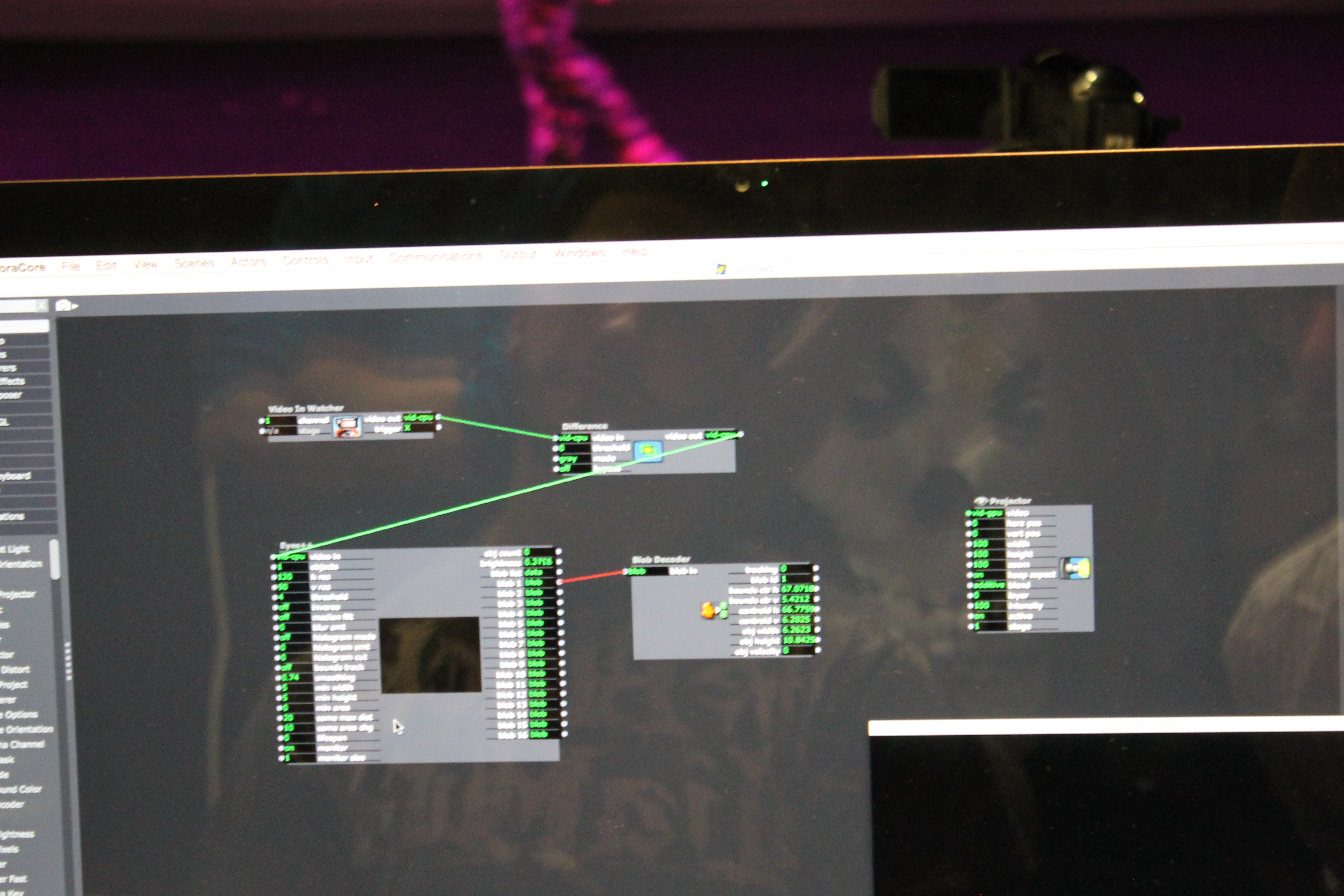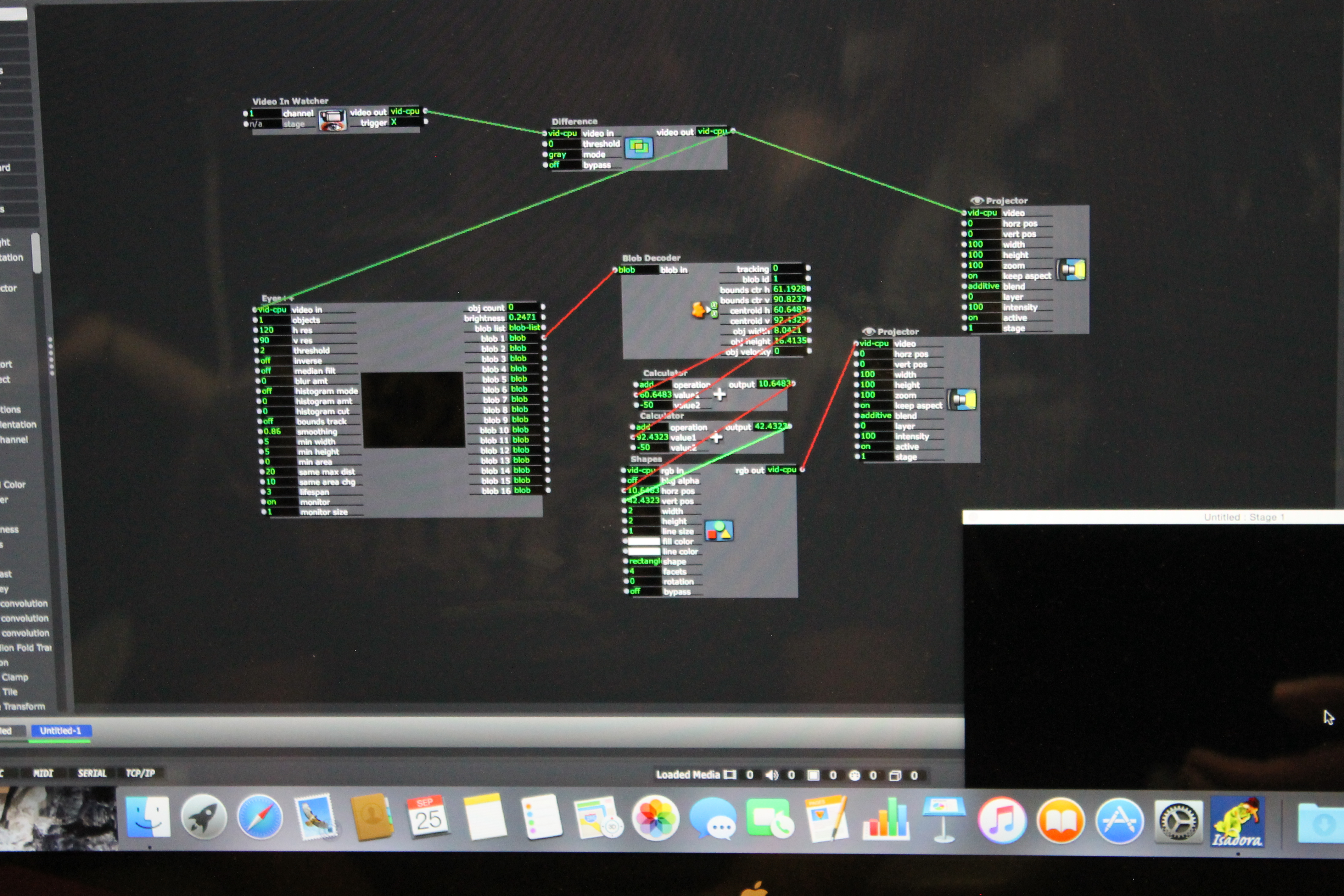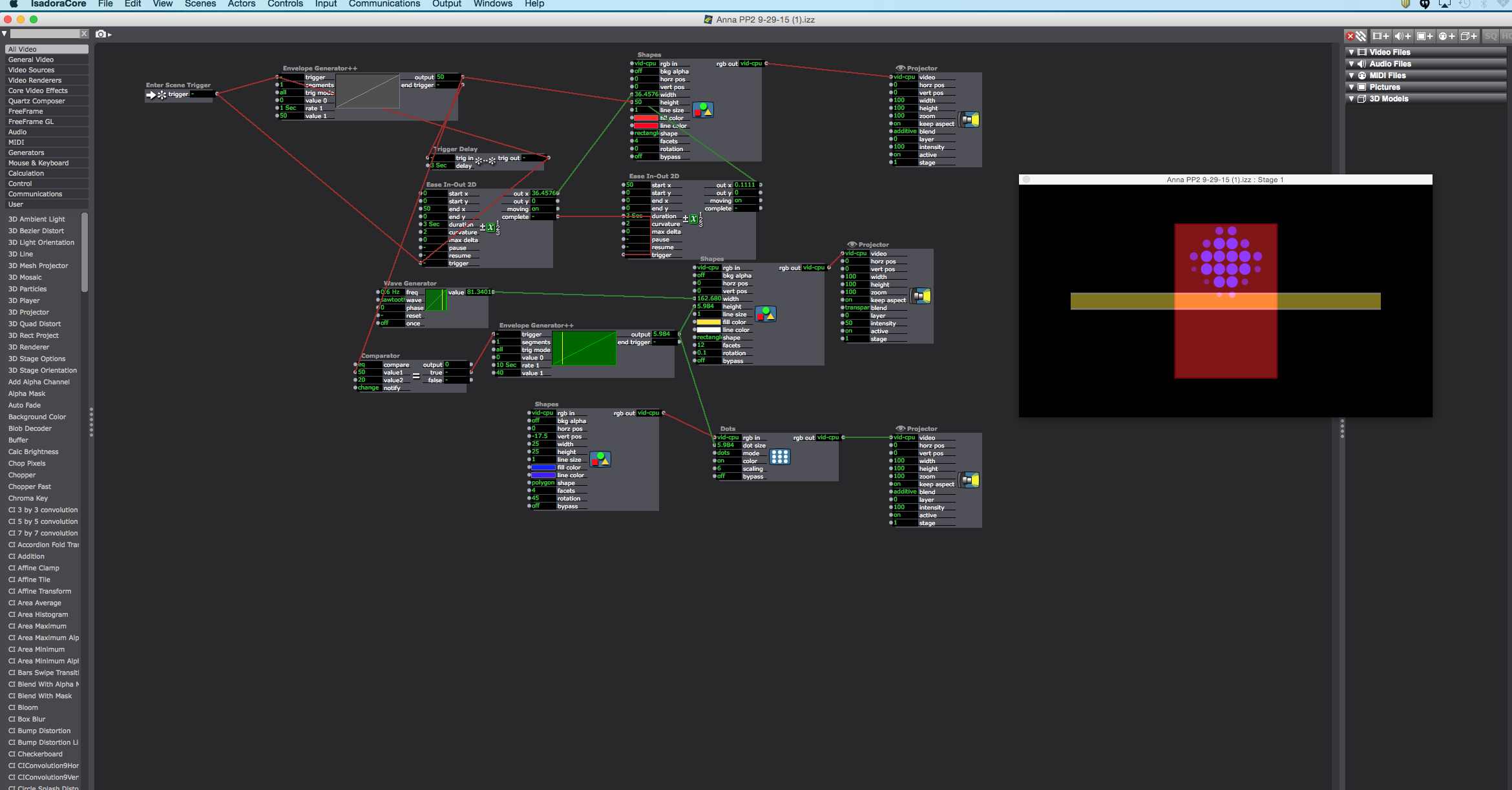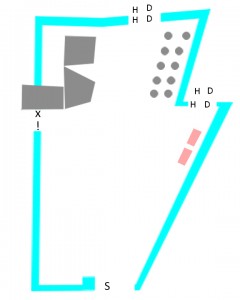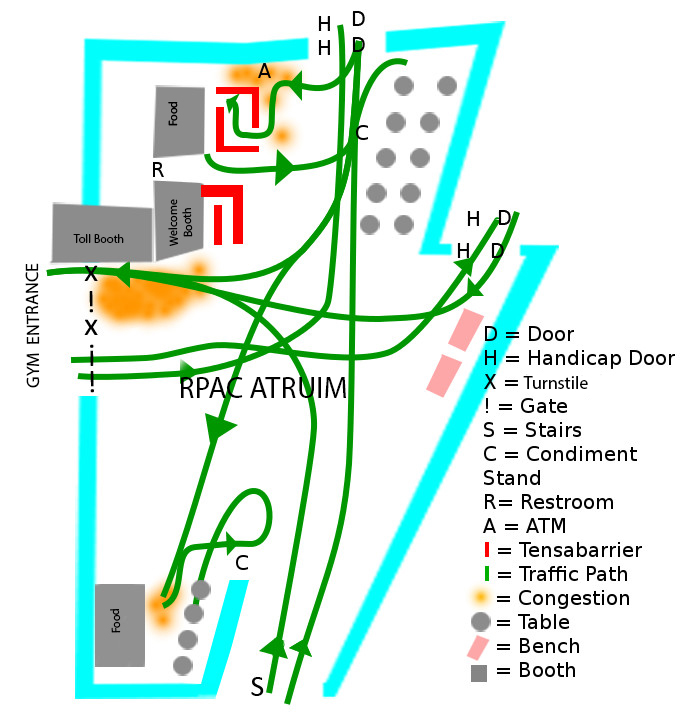Pictures from the Class MoCap Patch from Monday 09/28
Posted: September 30, 2015 Filed under: Uncategorized Leave a comment »
On this screen
- Video In Watcher – Camera input
- Difference – areas that change (eg. moving around on the screen) are brighter
- Eyes ++ – finds “blobs” (eg. an area where the actor/user is on the screen)
***
On this screen
- Start Live Capture Settings (don’t forget to click the show preview, or you will not see anything)
***
On this screen
- Eyes vs. Eyes ++
- no “Blob” detector, but it will give you tracking data (eg. Center, Height, Width, Velocity)
***
On this screen
- Eyes vs. Eyes ++
- no “Blob” detector, but it will give you tracking data (eg. Center, Height, Width, Velocity)
***
Duck… Duck… Duck. Duck…… Duck Duck……. Duck… Goose!!!
Posted: September 23, 2015 Filed under: Uncategorized Leave a comment »Let’s see…
Delightful: Check
Visually Pleasing: Oh yea!
Self generating patch of shapes, lines, and color: Check, check, and check (with a goose for good measure)
Level 1: System is fully automatic and only requires being ‘turned on’
Fully automated??? It’s practically self aware!
Level 2: System produces multiple visual ‘looks’ or ‘feels’
You got your duck look; you got your goose look.
Level 3: Any underlying pattern in the systems movement and visual state is complex enough that a human takes more than a few seconds to ‘understand the pattern.’
Everything is randomized, even the starting and stopping of the random sequences.
Bonus Level: System produces unexpected results over time.
No one expects a goose…
Bonus Level: Maintains a watchers attention for more than 20-30 seconds. (Much harder then one might guess. How do we do this in the theatre and dance? [Can your system tell a story?])
A complex visual tale of binary, conflicting pairs. Up and down, or left and right; never together.
This is a compressed copy with no audio.
I will elaborate on all this after I write the paper that is due tomorrow morning.
Dialog with Machines by Peter Krieg
Posted: September 16, 2015 Filed under: Jonathan Welch Leave a comment »Machine’s and Ideas
Modern computers can’t integrate arguments from different sources into new conclusions. They are unable to create comparatives, metaphors, or analogies, because they are essentially Turing machines (a hypothetical device that manipulates symbols on a strip of tape according to a set of rules, i.e. linear logic). The storage requirement for associative memory in a hierarchical structure increases exponentially as details add up. Data contained in capsulated in hierarchical structures, like the internet, has no comparative capabilities.
Biological Systems are Knowledge Based Polylogical Learning Systems
Hierarchical deductive inference system, like a computer, has only one way to look at things, but learning systems integrate patterns from external and internal events, and compare experiences to create new knowledge. It then uses the knowledge generated to transcend logical domain and apply the map to a new system. Biological systems create an abstract conceptual map of a solution and apply it no a new context. For example, a toddler taking the experiences objects falling combined with experience with the application of force to an object to come to the conclusion that when he or she pushes their plate off the table; it will fall onto the floor creating a mess.
Humans simulate “autopoipsis” (self organization a learning system develops through survival) in conversation. We abstract structural similarities between language and the adaptive behavior of survival. Data storage in cognitive systems can be thought of as generative, in the way we create conceptual symbols, rather than transcribe every event. For example, I might be read a long article, but I will probably only remember general idea as a sequence symbolic representations of the data I find relevant… (i.g. If I wasn’t taking notes, I would probably only remember this as a long article about how people are complex, and machines are dumb.)
Deep Blue Cheated, Virtual Reality Adapts, after that Everything gets Fuzzy
When you ask a person to factor 21, we don’t have to try every number until we get it right. A computer’s approach to problem solving is to test every possible solution, and though they can do this with increasing speed, it is an inefficient approach. While current computer technology does not think like we do, there are some similarities to our symbolic memory and the way some virtual reality systems are generating dynamic maps and dialogue. New “Pile Systems,” store data as input/output patterns.
On the last two pages Kreig describes Fuzzy Logic (which I cannot differentiate from a Pile System) and predicts the rise of the machines…
What’s Bugging Me About All That
He says “high end computers can handle 14 dimensions” (p.24), which seems to conflict with his premise of the mono-logical nature of computers?
At the top of page 24 Kreig says “knowledge system must be able to analyze data and create new data from it,” but isn’t that what a computer does, compare data with a function that generates an output? It does not create a new idea, just applies an existing formula to a pre-categorized set of variables, but doesn’t it generate new data?
How does quantum computing factor in? As I understand it, the “Q-Bits” these machines are based on use quantum “paradoxes” to be 1 and a 0 at once, rather than testing every solution as in a linear logic system. Isn’t this is essentially a Polylogical system?
He lost me on “Pile Systems” and “Fuzzy Logic.”
Doug Mann’s introduction to Jean Baudrillard
Posted: September 16, 2015 Filed under: Jonathan Welch Leave a comment »Doug Mann’s introduction to Jean Baudrillard relays a man with a philosophy on contemporary American society’s construction of a cultural reality with subjective tangibles and a history made malleable with philosophical semantics and media representation.
Baudrillard expanded on a Marxist categorization of objects as use vs. exchange, citing objects that have practical and prestigious value, and envisions a utopian future were gifts cease to be consumer objects and are exchanged for love (I wonder what he would have thought of Facebook, a consumer culture of virtual gifts).
The philosophy of simulacra, phases of imagery, and science fiction, was strangely analogous to neoromantic historian view of history and myth. Mircea Eliade’s (a historian concerned with myth and culture) philosophy of modern vs. “primitive” man’s connection to time and events is an odd parallel and inversion of Baudrillard’s writings on cultural shifts in the perception of reality. Both make extraordinary statements, and use a philosophical semantics to argue the validity through perceptually dependent “truths.” Eliade makes statements about archaic man’s freedom from the progression of time in a way that implies magical abilities to travel through time, and Baudrillard predicted that America would never enter the Gulf War, but they explain their claims, they describe a culturally constructed paradigm in which “actual” historical events are irrelevant. Conversely, Eliade believed modern man’s attachment to a “non-reversible” chronological history shackles us to an unchangeable reality that archaic man transcended through myth, contrasted with cultural progression to Baudrillard’s third order of simulacra, where we have created a disconnected virtual reality.
His views on seduction blatantly enforce an ignorant archaic stereotypical gender roles, and are not worthy of mention.
Pressure Project 1
Posted: September 16, 2015 Filed under: Jonathan Welch, Uncategorized Leave a comment »The location and time that I chose to schedule my Pressure Project, were less than optimal (the RPAC on Monday 09/07, the day on the labor day footmab game). There was little traffic and no congestion.
RPAC Atrium
Most of the congestion was in front of the one active turnstile, but they relieved it by opening the other.
The congestion near the tensabarriers in front of the food booth at the top was mainly from people looking at the menu, the food booth at the bottom had no barriers and less congestion.
The vast majority of the traffic came through the doors that did not have handicap access, and no one used the button to activate the doors.
A sadistic, and therefore interesting, social experiment would be to use the turnstiles for outgoing gym traffic instead of incoming, and change the incoming gym traffic to the left side and outgoing to the right.
I suspect this would create a great deal of frustration for both the patrons and the student employees, with outgoing traffic blocking the entrance/exit to argue with the attendant, people trying to come in the turnstiles on the right (as is typical for road traffic), and people trying to exit through the gates.











